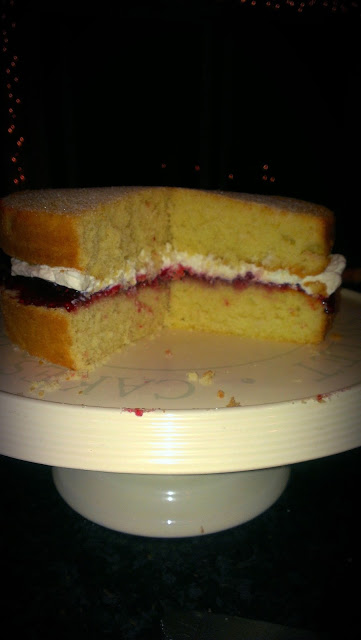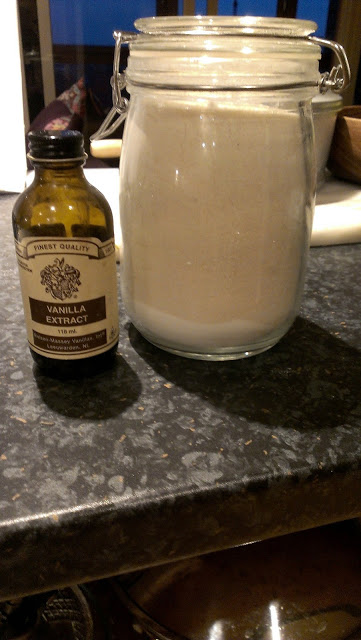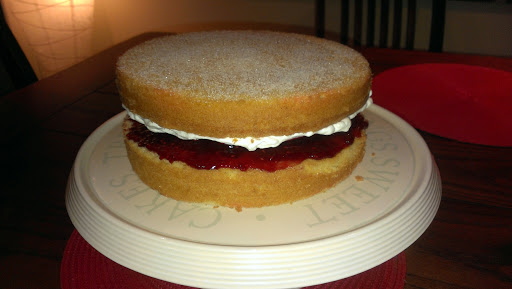I challenge anyone to resist home baking. There is something about it that makes me feel very nostalgic even though my mum didn’t bake when I was younger (that was Granny MacDonald’s job) and I came to it later in life.
I also challenge anyone who says they cant bake. You can. Sorry to be blunt about it but you can. Successful baking relies soley on following the instructions to the letter, using the correct bake ware and having the oven at the right temperature. Sure it takes time and practice to gain the confidence and perhaps improve your decorating skills which is why you start off with something simple and unfussy.
The more I baked cakes the more I came to know what to expect when certain ingredients mixed together and how to fix mistakes ergo my confidence and enjoyment grew. When you get to that point with a simple cake you can start knocking them out without having to consult the recipe and without really thinking about it.
And trust me, if I can bake then anyone can. I managed to set fire to a pot of spaghetti in Home Economics in High School.
Victoria Sponge Cake
 |
| Victoria Sponge with jam & cream |
Ingredients

Heat the oven to 170C. Grease & line 2 sandwich tins.
I do this by:
- Lay the tins on a sheet of greaseproof paper, draw around them & cut them out.
- Scrunch up a ball of cling film & use it to spread a lump of butter around the base & sides of the tins.
- Place the circle of paper in the base of the tin & smooth down.
- Toss 1tbsp of flour into each tin, tilt the tins over the sink & tap firmly to coat the sides.

Place a bowl or measuring jug onto the scales & set to 0. Crack eggs into the jug/bowl until you have between 220-240g of liquid eggs. This is usually approx 5 medium eggs. Add the vanilla & whisk to combine. Set the jug aside.
Whatever measurement your eggs was, this will be the same measurement for the butter, sugar & flour.
Measure out the same weight of butter & sugar and add to a bowl. Cream together using your preferred method (free-standing mixer, handheld electric whisk or wooden spoon) until they are combined and a pale yellow.
 |
| Creaming sugar & butter. |
Next, measure out the same quantity of flour & sift into a small bowl & set aside. You will need some of this when adding the eggs.
With the mixer on low (or if you are using a wooden spoon, beating well after each addition) add 2tbsp of the beaten eggs to the butter & sugar mixture with 1tbsp of the sifted flour.Make sure each addition is incorporated before you add the next. The flour will help stop the eggs & butter mixture curdling.
Once all the egg mixture has been added, sift in the remaining flour & mix well to ensure there are no lumps. While it may already have been sifted it cant hurt to add a little extra air to the batter. This will produce a very thick batter.
 |
| Evenly distribute the batter between the 2 tins & smooth the tops. |
Scrape this batter into the cake tins and divide as equally as possible. Smooth with the back of a spoon to ensure the surface is flat. Bake both cakes on one shelf for approx 35mins. Ovens will vary so I would check after 25-30mins just to be on the safe side. Try not to open the oven door before this or the cake may sink.
Check the cake is cooked by inserting a toothpick or kebab skewer into the middle of each cake. Leave it for a few seconds. If it comes out clean the cakes are cooked & ready. If not then pop it back into the oven for another 5-10mins. Try not to overcook or the sides will become crunchy.
Leave the tins on a cooling rack for 10mins. Run a knife around the sides of the cakes to loosen then flip onto the rack. If the cake doesn’t turn out immediately rap the bottom of the bottom of the tin with a knife to loosen or run the knife around the edges again. Carefully peel away the paper & leave to cool completely.
No oven is perfect & sometimes the cakes can be a little uneven. If this happens I shave away the top of each cake using a large bread knife until its even.
It also helps to sandwich the cakes together upside down, so the tops of the cake are sandwiched together and the bottom of the cakes (which are flat from the tin) face outwards making it more stable & easier to decorate.
Filling & Topping
Traditionally a Victoria sponge is filled with raspberry jam & dusted with sugar. Realistically you can go do what you like. Some ideas could be:
- Buttercream
- Lemon curd, jam
- Fruit & cream
- Chocolate ganache
My birthday cake used to get topping of white icing and hundreds & thousands but for a day to day cake I prefer jam, cream & a little sprinkling of vanilla caster sugar on top.
For this cake I spread Bonne Maman raspberry jam onto 1 cake. Whipped the cream until it formed soft peaks and spread this onto the 2nd cake. I sandwiched them together and sprinkled the top with a little vanilla sugar*
 |
| Whipped cream & raspberry jam filling |
* Vanilla Sugar
Good vanilla extract is expensive however a little goes a long way. If I want to reduce the amount of vanilla I use (or not use it at all) I keep a jar of vanilla sugar in my cupboard constantly topped up.
This is the simplest things to make & (in my opinion) makes a massive difference to cakes because the vanilla flavour & smell is infused throughout the whole cake but doesn’t make it feel sickly.

I bought a Kilner Jar which holds 500g of sugar. To this I added a used vanilla pod which I dried on some kitchen roll (you could however just add a fresh vanilla pod rather than a used one). Leave for a couple days & you have vanilla sugar.
This has lasted me years now & I only ever replace the pod perhaps once a year. And even when I top up the sugar it doesn’t take long for it to take on that warm vanilla scent.
Now I do also keep regular caster sugar (resorting to vanilla sugar for a cuppa tea when I have ran out of the regular stuff is never fun). But that’s not hard because I buy a 1 kilo bag of sugar & my jar holds 500g.

